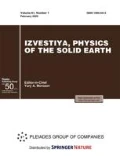Abstract
The process of multiple self-nucleation and ascent of mantle plumes is studied in the numerical models of thermal convection. The plumes are observed even in the simplest isoviscous models of thermal convection that leave aside the more complex rheology of the material, thermochemical effects, phase transformations, etc., which, although controlling the features of plumes, are not necessary for their formation. The origin of plumes is mainly due to the instability of the mantle flows at highly intense (low-viscous) thermal convection. At high viscosity, convective flows form regular cells. As viscosity decreases, the ascending and descending flows become narrower and unsteady. At a further decrease in viscosity, the ascending plumes assume a mushroom-like shape and occasionally change their position in the mantle. The lifetime of each flow can attain 100 Ma. Using markers allows visualizing the evolution of the shape of the mantle plumes.
Similar content being viewed by others
References
Evseev, A.N., The Mantle Convection and Phase Transformations, Abstracts of Papers, IX mezhdunarodnoe soveschanie “Fiziko-khimicheskie i petrofizicheskie issledovaniya v naukakh o Zemple (IX Int. Conf. “Physicochemical and Petrophysical Studies in the Earth Science”), Moscow: IFZ RAN, GEOKhI RAN, 2008.
Grachev, A.F., Mantle Plumes and Problems of Geodynamics, Izv. Phys. Earth, 2000, vol. 36, no. 4, pp. 263–294.
Trubitsyn, V.P., Equations of Thermal Convection for a Viscous Compressible Mantle of the Earth Including Phase Transitions, Izv. Phys. Earth, 2008, vol. 44, no. 12, pp. 1018–1026.
Trubitsyn, V.P., Evseev, A.N., Baranov, A.A., and Trubitsyn, A.P., Phase Transition Zone Width Implications for Convection Structure, Izv. Phys. Earth, 2008, vol. 44, no. 8, pp. 603–614.
Trubitsyn, V.P. and Kharybin, E.V.,?Thermochemical Mantle Plumes, Dokl. Earth Sci., 2010,? vol. 435,part 2, pp.? 1656–1658.
Davies, G.F., Dynamic Earth, Cambridge: Cambridge Univ. Press, 1999.
Foulger, G.R., Plates vs. Plumes: A Geological Controversy, Wiley-Blackwell, 2010.
Moresi, L.N. and Solomatov, V.S., Numerical Investigation of 2D Convection with Extremely Large Viscosity Variations, Phys. Fluids, 1995, vol. 7, pp. 2154–2162.
Moresi, L., Zhong, S.J., and Gurnis, M., The Accuracy of Finite Element Solutions of Stokes’ Flow with Strongly Varying Viscosity, Phys. Earth Planet. Int., 1996, vol. 97, pp. 83–94.
Schubert, G., Turcotte, D.L., and Olson, P., Mantle Convection in the Earth and Planets, Cambridge: Cambridge Univ. Press, 2001.
Tackley, P.J. and Xie, S., The Thermochemical Structure and Evolution of Earth’s Mantle: Constraints and Numerical Models, Phil. Trans. R. Soc. Lond. A, 2002, vol. 360, pp. 2594–2609.
Author information
Authors and Affiliations
Additional information
Original Russian Text © V.P. Trubitsyn, A.N. Evseev, M.N. Evseev, E.V. Kharybin, 2011, published in Fizika Zemli, 2011, No. 12, pp. 3–10.
Rights and permissions
About this article
Cite this article
Trubitsyn, V.P., Evseev, A.N., Evseev, M.N. et al. Mantle plumes in the models of quasi-turbulent thermal convection. Izv., Phys. Solid Earth 47, 1027–1033 (2011). https://doi.org/10.1134/S106935131112010X
Received:
Published:
Issue Date:
DOI: https://doi.org/10.1134/S106935131112010X



